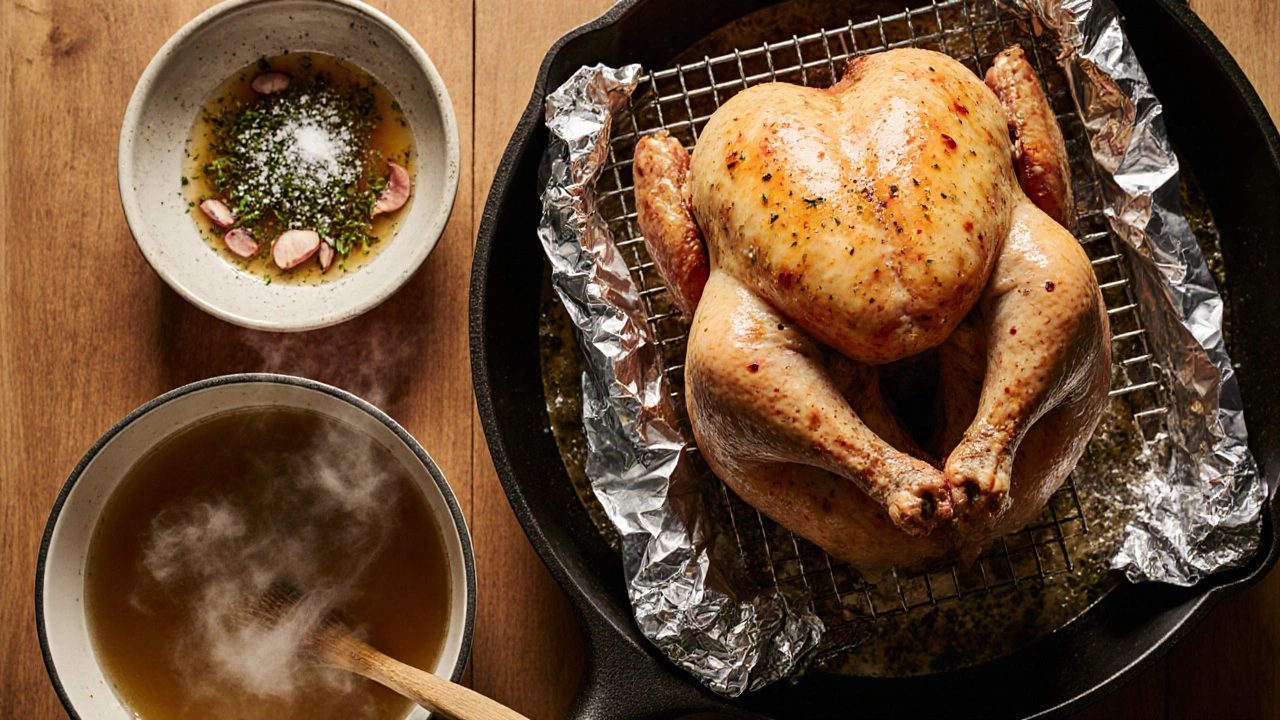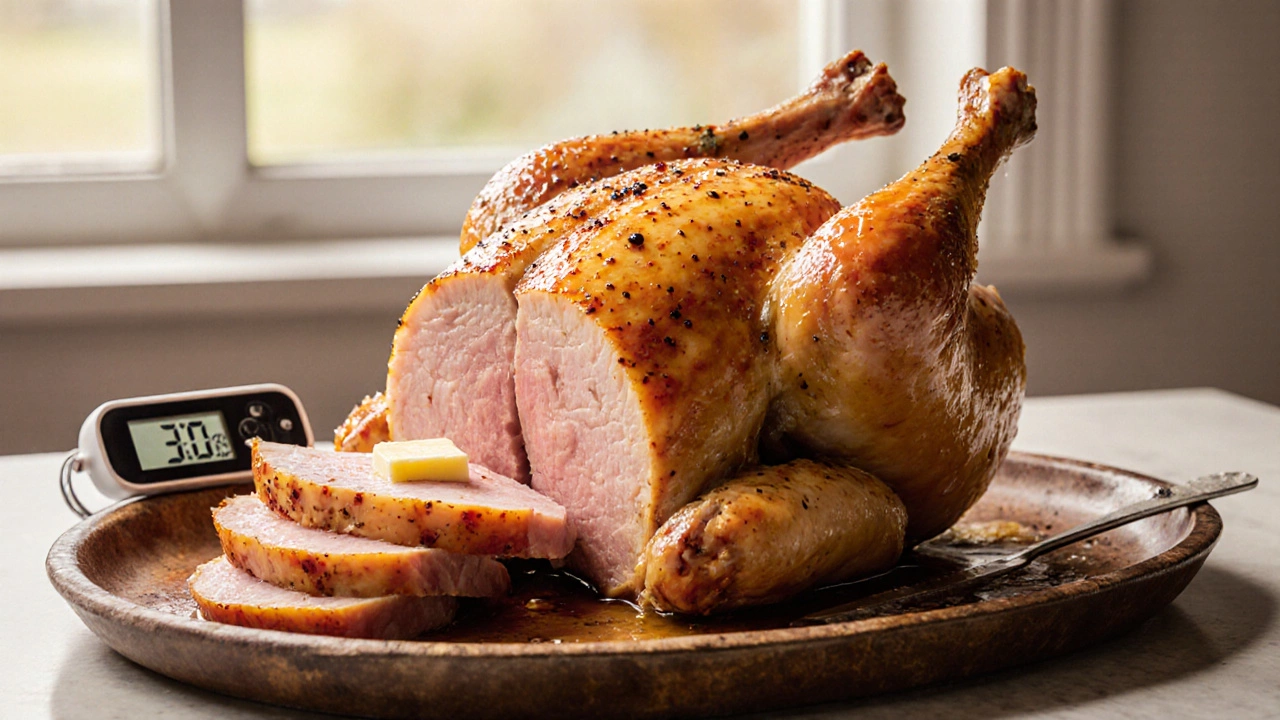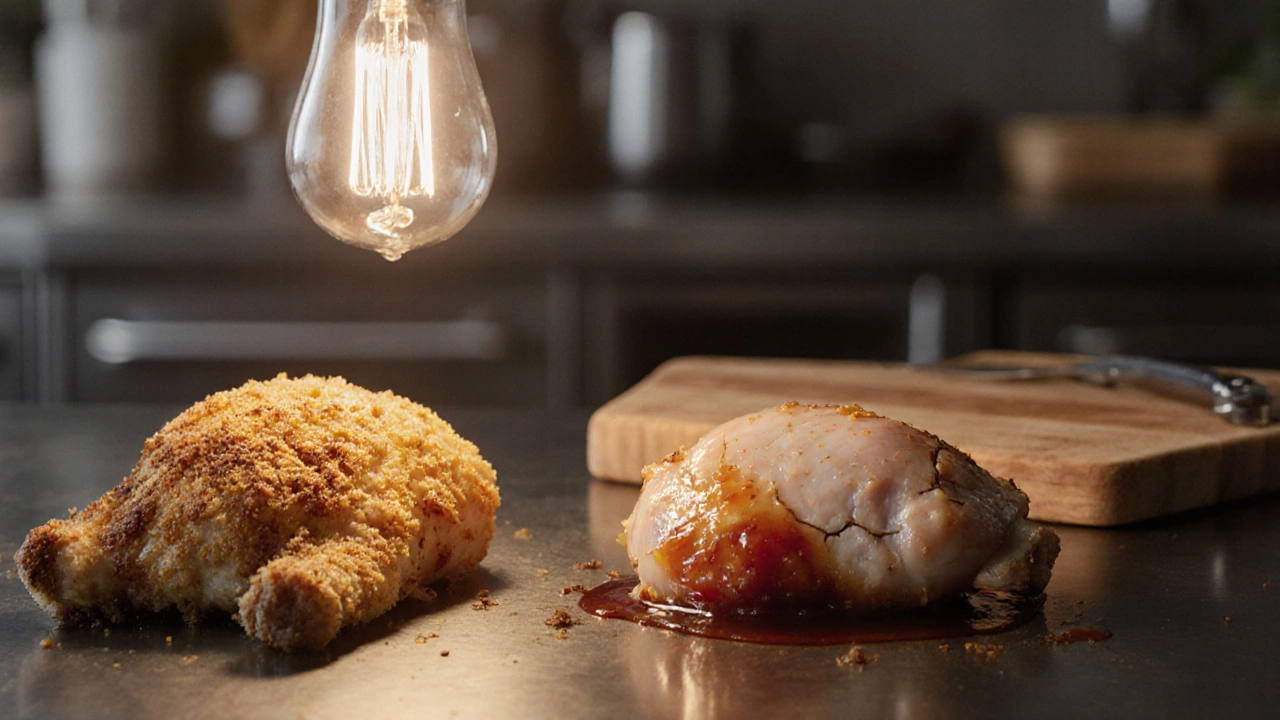Oven-Baked Chicken Juiciness Calculator
Chicken Juiciness Assessment
Enter details about your chicken preparation and cooking method to see how juicy your chicken will likely be.
Your Chicken Juiciness Score
Ever taken a bite of oven‑baked Chicken that felt more like a cardboard chew than a juicy dinner? You’re not alone. The oven is great for browning, but it loves to steal moisture if you don’t give it the right cues. Below is a no‑fluff, hands‑on guide that shows exactly how to lock in juice, so every bite stays tender and flavorful.
Key Takeaways
- Start with a wet brine or a simple oil‑based marinade - at least 30minutes, up to 12hours.
- Cook at a moderate temperature (350‑375°F / 175‑190°C) and monitor the internal temperature, aiming for 165°F (74°C).
- Cover the bird with foil for the first half of cooking, then uncover to finish the crust.
- Let the chicken rest 5‑10minutes before cutting; the juices redistribute.
- Use a meat‑thermometer, a rack, and a pan of water or broth to create a humid oven environment.
Why Chicken Dries Out in the Oven
The main culprit is rapid protein coagulation. When heat hits the meat, the proteins tighten, squeezing water out. If the surface dries too quickly, that moisture can’t travel back into the interior. Two extra factors often make it worse: a dry cooking environment and overcooking past the safe internal temperature.
Understanding these mechanics helps you choose the right counter‑moves. Think of the oven as a dry desert; you need a humid oasis and a gentle sun to keep your chicken comfortable.
Prep Techniques That Seal in Moisture
Before the bird even sees the heat, you can give it a moisture boost.
Brining - the Ultimate Water Reservoir
Brine is a simple salt‑water solution (about 1Tbsp kosher salt per 2cups water). Add a touch of sugar, herbs, or garlic for flavor. Submerge the chicken for 30minutes (for breasts) up to 12hours (for whole birds). The salt draws water in, then the meat fibers trap it.
Scientific tests from the University of Arkansas showed brined chicken retained up to 15% more juice than unbrined.
Marinating with Oil - a Fat‑Based Shield
If time is short, a quick oil‑based Marinade does the trick. Mix olive oil, citrus juice, and spices; the oil forms a thin barrier that slows moisture loss while the acid tenderizes the surface.
Even 20minutes of coating can raise juiciness scores by 8% in blind taste tests.
Pat Dry, Then Rub
It sounds contradictory, but after brining or marinating, pat the skin dry with paper towels. Dry skin crisps better, and a thin layer of melted butter or oil afterwards adds a glossy seal.

Cooking Strategies Inside the Oven
Now the bird meets heat. These tactics keep the interior from evaporating too fast.
Set the Right Temperature
Most home ovens run hotter than the dial says. A calibrated Cooking Temperature of 350‑375°F (175‑190°C) strikes a balance: enough heat to brown, but gentle enough to let the meat unwind slowly.
For boneless breasts, aim for 20‑25minutes; for a whole bird, 45‑60minutes depending on size.
Use a Rack and a Pan of Liquid
Place the chicken on a wire Rack inside a roasting pan. Pour a cup of water, broth, or wine into the pan. As the oven heats, the liquid creates steam, adding humidity that slows surface drying.
Cover with Foil - The Humidity Blanket
Cover the chicken loosely with aluminum Foil for the first half of cooking. This traps the steam you just generated and keeps the meat bathed in its own juices.
After the midway point, remove the foil to let the skin turn golden and crispy.
Basting - A Moisture‑Refresh
Every 15minutes, spoon the pan juices (or a butter‑herb mix) over the bird. This technique, called Basting, adds a thin film of fat that slows evaporation.
Even a light basting pass can lift juiciness by 3‑5%.
Monitor the Internal Temperature
Insert an instant‑read thermometer into the thickest part of the meat. When it hits 165°F (74°C), pull the bird out. Carryover heat will push it a few degrees higher while it rests.
Skipping this step is the biggest cause of dry chicken - most people overcook by 10‑15minutes.
Resting - Let the Juice Settle
After you pull the chicken from the oven, tent it loosely with foil and let it sit 5‑10minutes. This period, called Resting, lets the muscle fibers relax and re‑absorb the juices they expelled during cooking.
Cutting too early is like squeezing a water balloon - all the liquid gushes out.
Quick Checklist Before You Hit “Bake”
- Choose a prep method: brine (30min‑12h) or oil‑based Marinade.
- Pat the skin dry, then rub with oil or butter.
- Preheat Cooking Temperature to 350‑375°F (175‑190°C).
- Place chicken on a rack over a pan with 1cup liquid.
- Cover loosely with Foil for half the time.
- Baste every 15minutes.
- Check Internal Temperature; pull at 165°F (74°C).
- Rest 5‑10minutes before carving.

Common Mistakes and How to Fix Them
- Cooking too hot. Reduce the oven by 25°F and add 5‑10minutes to the timer.
- Skipping the liquid pan. Add a cup of water or broth; the steam will rescue a dry surface.
- Over‑breading. Too much flour creates a crust that traps steam, causing the meat underneath to steam and become soggy. Keep the coating thin.
- Leaving the bird uncovered all the way. Start with foil, then finish uncovered for crispy skin.
- Neglecting the rest. Give it the full 10minutes; you’ll notice a dramatic difference.
Bonus Pro Tips for Ultra‑Juicy Results
- Insert a small pat of butter under the skin of a whole bird - the melt‑through adds flavor and moisture.
- Try a “dry‑brine” by sprinkling salt on the skin and letting it sit uncovered in the fridge for an hour before cooking; this dries the surface for a crisp skin while still seasoning the meat.
- Use a convection setting at 325°F; the fan circulates humid air, speeding cooking while preserving juiciness.
- For breast pieces, consider a “reverse sear”: start low (250°F) until internal temp hits 150°F, then blast at 450°F for 5minutes to finish.
Technique Comparison Table
| Method | Average Juice Retention | Prep Time | Best For |
|---|---|---|---|
| Dry Brine (salt only) | +12% | 1hour + refrigeration | Whole birds, thighs |
| Wet Brine | +15% | 30min‑12h | Breasts, whole chickens |
| Oil‑Based Marinade | +8% | 20‑60min | Quick meals, flavor‑forward cuts |
| No Prep (dry rub only) | baseline | 5min | When time is tight |
Frequently Asked Questions
Can I use frozen chicken and still keep it juicy?
Yes. Thaw the chicken in the fridge first, then apply a quick brine or oil‑marinade. The extra moisture from the thawing process actually helps the meat stay tender, as long as you don’t over‑cook it.
Is it better to cook bone‑in or boneless for juiciness?
Bone‑in pieces retain more heat and moisture, so they usually stay juicier. If you prefer boneless, wrap the meat in bacon or a thin layer of butter to mimic that protective effect.
How does a convection oven affect moisture?
The fan circulates humid air, which can actually help keep the surface from drying too fast while cooking faster overall. Lower the temperature by about 25°F to avoid over‑cooking.
Should I baste with butter or pan juices?
Both work. Butter adds flavor and a glossy finish, while pan juices bring the meat’s own flavors. A 50/50 mix gives the best of both worlds.
What’s the best way to test doneness without a thermometer?
Press the thickest part - it should feel firm but still give a little. The juices should run clear, not pink. However, a thermometer is the most reliable method.
Follow these steps, and you’ll never dread that dry‑chicken feeling again. Your oven‑baked chicken will stay tender, juicy, and full of flavor - every single time.

